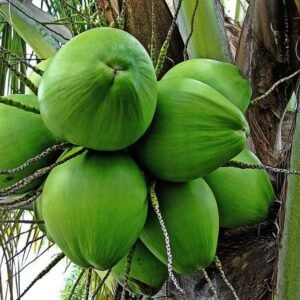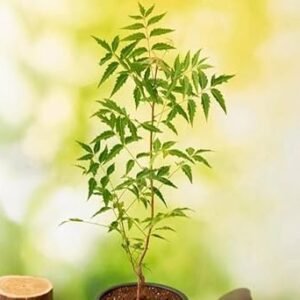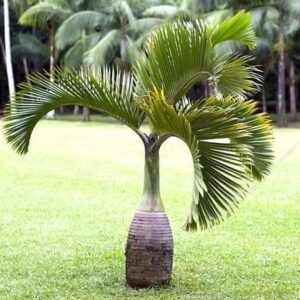Description
Gudhal (Hibiscus) Plant – A Comprehensive Overview
The Gudhal plant, scientifically known as Hibiscus rosa-sinensis, is a widely admired flowering plant known for its large, vibrant blossoms. It belongs to the Malvaceae family and is native to East Asia, although it has been naturalized in many tropical and subtropical regions across the globe. In English, it is commonly referred to as Hibiscus or China Rose, and it holds great ornamental, medicinal, and cultural value, especially in countries like India, China, Hawaii, and parts of Africa and the Caribbean.
Botanical Description
- Scientific Name: Hibiscus rosa-sinensis
- Common Names: Gudhal (Hindi), Shoe Flower, China Rose, Hawaiian Hibiscus
- Family: Malvaceae
- Origin: Likely native to East Asia, now widely cultivated worldwide
The Gudhal plant is typically a bushy shrub that can grow to heights of 5–10 feet (1.5–3 meters). It has glossy, dark green leaves with serrated edges and a smooth texture. The flowers, which bloom singly in the leaf axils, are the plant’s most striking feature. These blossoms are generally large, trumpet-shaped, and can measure up to 6 inches (15 cm) in diameter. They are available in various colors, including red, pink, yellow, white, and orange, though red is the most common and culturally significant in many regions.
Types of Hibiscus
There are many species of Hibiscus, but Hibiscus rosa-sinensis is the most widely cultivated for ornamental and traditional use. Other notable types include:
- Hibiscus syriacus – Known as Rose of Sharon
- Hibiscus sabdariffa – Known for its edible calyces used in teas (Roselle)
- Hibiscus mutabilis – Commonly called Confederate Rose
Each type has unique properties, but all share the characteristic five-petal flower and prominent central stamen column.
Cultural and Religious Significance
In India, the Gudhal flower holds immense religious importance. It is especially sacred to Goddess Kali and Lord Ganesha, and is often used in offerings during Hindu rituals and festivals. The red hibiscus, in particular, symbolizes power, strength, and divine feminine energy (Shakti).
In Hawaii, the hibiscus is the state flower and symbolizes hospitality and delicate beauty. Women often wear it behind the ear to signify relationship status—left for taken, right for single.
Medicinal Uses
Gudhal is not just a decorative plant; it is also revered in Ayurvedic, Unani, and traditional Chinese medicine for its therapeutic properties.
Key medicinal uses:
- Hair and Scalp Health:
- Hibiscus is known to stimulate hair growth, prevent hair fall, and combat dandruff. A paste made from its leaves and flowers is commonly applied to the scalp.
- Hibiscus oil and shampoo are popular in herbal hair care.
- Skin Care:
- The plant has anti-aging and moisturizing properties. Its extracts are often found in natural face packs and creams.
- Heart Health:
- Hibiscus tea, made from Hibiscus sabdariffa, helps lower blood pressure and cholesterol levels. It has antioxidant and anti-inflammatory effects.
- Digestive Benefits:
- The leaves and flowers are used to treat indigestion and enhance appetite.
- Immune System:
- Rich in Vitamin C and antioxidants, hibiscus boosts immunity and helps prevent infections.
- Menstrual and Reproductive Health:
- Gudhal is believed to help balance hormones and regulate menstrual cycles.
Note: While hibiscus is generally safe, excessive use or consumption should be avoided during pregnancy and for people with low blood pressure without consulting a healthcare provider.
Hibiscus Tea
Hibiscus tea, made primarily from dried Hibiscus sabdariffa flowers, is a deep crimson herbal infusion. It is caffeine-free and consumed both hot and cold. Its tangy, cranberry-like flavor and health benefits make it a popular drink across many cultures.
Health Benefits of Hibiscus Tea:
- Antioxidant-rich
- Aids in weight loss
- Reduces blood pressure
- Improves liver health
- Helps manage blood sugar levels
Cultivation and Growing Conditions
The Gudhal plant is relatively easy to grow and maintain, making it popular among gardeners.
Growing Conditions:
- Climate: Thrives in warm, tropical, and subtropical climates.
- Soil: Prefers well-drained, fertile loamy soil with slightly acidic to neutral pH (6.0–7.5).
- Sunlight: Requires full sunlight (at least 6 hours/day) for optimal flowering.
- Watering: Regular watering is essential but avoid overwatering. Water deeply once or twice a week depending on weather.
Propagation:
- Mostly propagated through stem cuttings during spring or early summer.
- Seeds can also be used, but the flowering takes longer.
Pruning:
- Regular pruning encourages bushier growth and more flowering.
- Prune in early spring before new growth begins.
Fertilization:
- Use balanced fertilizers (e.g., 10-10-10 NPK) or organic compost monthly during the growing season.
Pests and Diseases:
- Common pests: Aphids, mealybugs, whiteflies, and spider mites.
- Fungal diseases like leaf spot and root rot can occur if poorly drained.
Uses Beyond Medicine
- Ornamental: Hibiscus is a popular ornamental plant for gardens, hedges, and landscape design due to its vibrant flowers.
- Natural Dye: Flowers are used to produce natural dyes for fabrics and hair.
- Cosmetic: Used in shampoos, conditioners, lotions, and face masks.
- Culinary: Some species, especially Hibiscus sabdariffa, are used in making jams, jellies, and sauces.
Ecological Role
- Attracts pollinators like bees, butterflies, and hummingbirds.
- Can be used in rain gardens and helps control erosion due to its dense root system.
- Acts as a natural air purifier and enhances the biodiversity of gardens.
Conclusion
The Gudhal or Hibiscus plant is a remarkable blend of beauty, utility, and spiritual symbolism. Its stunning flowers make it a favorite in gardens, while its deep-rooted presence in traditional medicine and rituals shows its importance beyond aesthetics. Whether as a health remedy, sacred offering, or vibrant bloom, the hibiscus remains one of nature’s most treasured gifts.






 Wish Good Luck With 3 Layer Lucky Bamboo in a Glass Vase with Pebbles
Wish Good Luck With 3 Layer Lucky Bamboo in a Glass Vase with Pebbles  Mini Succulent Garden Pack
Mini Succulent Garden Pack  River Pebbles (White, Big, Unpolished) - 2 kg
River Pebbles (White, Big, Unpolished) - 2 kg  PENCIL PINE -PLANT
PENCIL PINE -PLANT 

Reviews
There are no reviews yet.